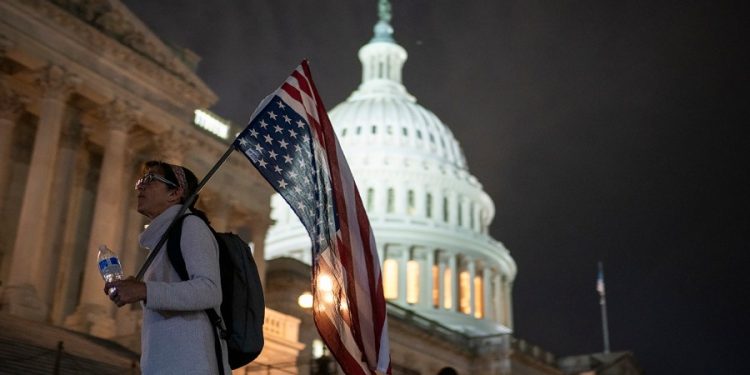Congressional Republicans are moving quickly to pass a mammoth tax and spending cuts package that could have a direct impact on millions of Americans, and drastic consequences for the economy.
The 1,000-plus page bill recently passed by the House would extend tax cuts set to expire as part of President Trump’s signature 2017 tax law, provisions aimed at nixing taxes on tips and overtime pay.
It also includes a host of reforms to programs like Medicaid and food stamps that early estimates project could reduce spending in those areas by hundreds of billions of dollars in the next decade.
As Senate Republicans look to make their own changes to the package, here’s five pieces of the House bill that could make waves across American life.
Tax cuts across the board
The centerpiece of the House measure is an extension and expansion of Trump’s 2017 tax cut law.
The most significant part of the tax provisions may actually be the least noticeable: the cementing of current personal income tax rates. Rather than providing a big tax cut, the bill instead prevents a major increase in taxes that would have occurred next year.
But the House bill also includes several new tax cuts that could boost take-home pay for Americans across a wide range of income levels and demographics.
On the lower end of the income spectrum, the bill would increase the child tax credit, eliminate taxes on most tips and overtime pay, and provide a credit to cover the cost of taxes on Social Security benefits.
The bill also includes a significantly higher cap on the state and local tax (SALT) deduction, which primarily benefits residents of high-income, high-tax cities and their suburbs.
Medicaid cuts could impact millions
Much of the savings in the legislation comes from Medicaid.
The bill would cut nearly $800 billion from the program through a combination of provisions including work requirements on “able-bodied adults” through age 64 without dependents, a freeze on provider taxes, more frequent checks of people’s eligibility, and reducing federal Medicaid payments to states that provide healthcare coverage for undocumented immigrants.
The Congressional Budget Office estimated close to 10 million people would lose insurance coverage as a result.
The Medicaid provision with arguably the most direct impact on beneficiary coverage would be the provision for anyone “able bodied” between the ages of 19 and 64 to work, go to school or volunteer for 80 hours a month—and then prove it. The requirements are the most stringent Republicans have ever put forward.
Most of the coverage losses would be from people who are eligible but aren’t able to meet the reporting requirements.
Under pressure from conservatives, GOP leaders amended an initial version of the bill to enact the changes by the end of 2026 at the latest, a timeframe that experts and advocates warn will lead to rushed implementation by states and even more people losing insurance.
Outside of Medicaid, the legislation also would codify into law some technical and controversial changes President Trump proposed to make to the Affordable Care Act. Among other changes, the bill would end automatic reenrollment in ACA plans for people getting subsidies, end certain special enrollment periods, and shorten the overall open enrollment.
According to CBO, the ACA changes would result in 3 million additional uninsured people.
Cuts to SNAP funding to states
Senate Republicans have already indicated changes are possible regarding some of the proposed reforms to the Supplemental Nutrition Assistance Program (SNAP) crafted in the House.
The bill would require states to cover a share of SNAP benefits costs, which are currently completely funded by the federal government. The bill would lower the federal share of the cost of SNAP from 100 percent to 95 percent starting fiscal 2028.
The bill also includes language that would increase states’ shares of the costs in fiscal 2028 depending on their payment error rates – a move that proponents say would hold states accountable for billions of dollars in erroneous payments to participants annually.
If the error rate is 6 percent or higher, states would be subject to a sliding scale that could see their share of allotments rise to a range of between 15 percent and 25 percent.
Democrats have sharply criticized the proposal, which they argue could lead to states cutting benefits on their own.
In fiscal 2023, data from the U.S. Department of Agriculture showed that the national payment error rate was 11.68 percent. Most states on the list have payment error rates, which factors in a state’s overpayments and underpayments, above 6 percent.
Other proposals in the bill would beef up work requirements for the program, seek to block the federal government from being able to increase monthly benefits in the future, and increase states’ share of costs to administer SNAP.
Electricity prices could rise
The legislation guts massive subsidies for climate-friendly energy sources, including wind and solar power.
Doing so is expected to have significant ramifications on not only the nation’s greenhouse gas emissions but also energy prices.
A recent analysis from BloombergNEF said that a repeal of the green tax credits would result in 17 percent less renewable construction. It said that the cut, combined with growing electricity demand, is “a recipe for spiking power prices.”
Ethan Zindler, policies and countries analyst with BloombergNEF, said that for analysis purposes, the changes made in the House bill are akin to a full repeal.
“The tax code at the moment helps to reduce the cost of electricity for consumers from renewables, which today account for the vast majority of what gets added to the grid,” he said.
“if you remove those supports, then developers will simply seek to charge more, and in a number of cases, utilities will be forced to pay more, and those costs will flow through to consumers.”
Several analyses estimate that electric bills could rise noticeably as a result.
A Rhodium Group estimate has found that keeping the tax credits in place could save consumers 2 to 4 percent on their electric bills in 2030 and 2 to 5 percent in 2035. Aurora Energy Research has found that removing the tax credits will increase electric bills by an average of 10 percent – or $142 per year – by 2040.
Higher debt and interest rates
While the House bill has a long way to go before it becomes law, it’s already sending shockwaves through financial markets.
Bond traders have sent U.S. interesting rates rising as the House advanced a bill that most budget scorekeepers project to add at least $4 trillion to the debt over the next decade.
This could trickle through to the housing market and credit markets, adding another economic squeeze into the mix.
“Everybody I’ve talked to in the financial markets, they’re staring at the bill, and they thought it was going to be much more in terms of fiscal restraint, and they’re not necessarily seeing it,” Federal Reserve Governor Christopher Waller said in an interview last week on Fox Business Network’s “Mornings with Maria.”
“Therefore, there’s going to be a lot of issuance of Treasuries. And in order for them to buy these things, they want it at a lower price, and therefore, a higher yield,” he said.
Some House fiscal hawks held their noses and voted for the measure despite their concerns, but several GOP senators have already pledged to vote against the bill given its bond market impact.
“I think we’re having trouble selling our long bonds already,” warned Sen. Rick Scott (R-Fla.), who cited the rising interest rates.
“I want to get a deal done; I support the president’s agenda. I support the border, I support the military, I support extending the Trump tax cuts — but we have to live in reality. But we got to live in reality here: We got a fiscal crisis,” Scott said.














